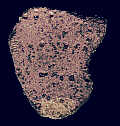The barrow cemetery
The Bronze Age interest at Carden has previously focused on the barrow cemetery. The only real information about it comes from a brief description given by the Cheshire historian George Ormerod, writing shortly before 1819. He describes “the enormous tumulus of Coddington, and to the left of it, in and near Carden are several smaller tumuli, one of which is in a field south-east of the hall, where some Roman urns were discovered a few years ago”. The description of the urns as Roman is unsurprising: in the late eighteenth and early nineteenth centuries many prehistoric artefacts were believed to have been Roman in date. It must be assumed that the barrow southeast of the Hall is that which still exists and was identified in 1991 by David Higgins of the now defunct Liverpool University Field Archaeology Unit.
William Shone Jr, the local antiquary, unfortunately muddled Ormerod’s account with a barrow cemetery at Jodrell Bank in Twemlow. This has misled recent archaeologists (including one of the project directors – me!) who have been looking for five mounds close to the brook beside Stretton Mill. The explanation for this error is probably to be sought in Shone’s preparatory notes: in his book he describes Egerton Leigh as the owner of Carden Hall, whereas the Egerton Leighs were owners of Jodrell Hall, where the barrow cemetery described by Shone still exists. The owner of Carden was actually John Hurleston Leche. Presumably, Leigh and Leche became muddled in his notes, causing the present confusion.
Trench I
 In
the 1998 season, something rather unexpected happened. In
dismantling a structure that appeared to have been put up by the
hermit in the mid-eighteenth century, we began to find pieces of
Bronze Age pottery, dating from about 2200-1800 BC. One of them
was decorated with incised lines, while another looked very like
a plain sherd from a Beaker style vessel. Nearby, a few scraps of
badly eroded burnt human bone (including the distal – or
hand – end of a radius) were found.
In
the 1998 season, something rather unexpected happened. In
dismantling a structure that appeared to have been put up by the
hermit in the mid-eighteenth century, we began to find pieces of
Bronze Age pottery, dating from about 2200-1800 BC. One of them
was decorated with incised lines, while another looked very like
a plain sherd from a Beaker style vessel. Nearby, a few scraps of
badly eroded burnt human bone (including the distal – or
hand – end of a radius) were found.
This began to intrigue us. Beakers are associated especially with ritual sites – henges and burials – and we wondered if we had a very disturbed burial. Beaker burials have been found in caves, so it is possible that John Harris removed this material when he moved in to the cave in 1744 and incorporated into a small structure outside its mouth. On the other hand, the majority of deposits can be shown stratigraphically to belong to the Bronze Age.
Even more puzzling is what appears to be a revetment along the line where there is a break of slope. The talus extends out from the cave mouth on a roughly level surface for about four to five metres. It then has a sudden break, becoming quite steep for a distance of two or three metres, then becomes much gentler. We had assumed that the underlying geology had caused this. It now looks as if there is a deliberate bank of large stones along this break. The stratigraphy of the site indicates that this was laid in the Bronze Age.